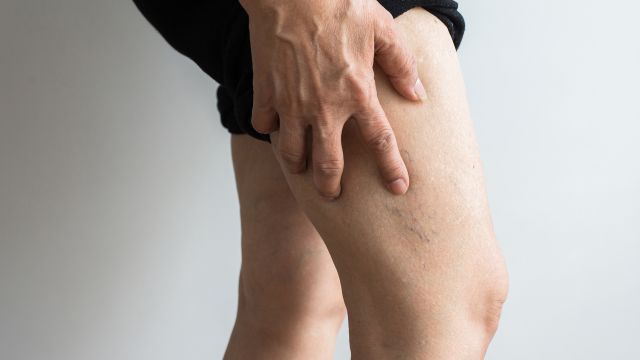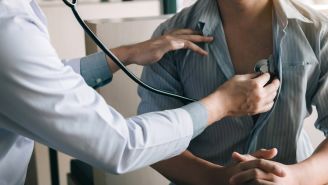Updated on April 29, 2024.
Anyone can get spider veins, but they’re more likely to appear later in life and are much more common among women. In fact, more than half of women will develop these thin, bluish, spiderweb-like veins that most often appear on the legs.
Unlike varicose veins, which bulge from the skin and occasionally lead to more serious issues, spider veins are usually not painful and typically don’t require medical treatment. But that doesn’t mean you have to like them, or even live with them.
Some people may feel self-conscious about existing spider veins, while others may worry about getting them. If you’re wondering what causes spider veins, how you might be able to minimize them, or what you can do to get rid of them, we’ve got answers.
Spider veins vs. varicose veins
The exact cause of spider veins isn’t clear, but they usually form when veins are weakened and damaged.
Healthy veins work to push blood to the heart. But when the valves weaken, the blood flows backwards and collects in the veins. Over time, this extra pressure can lead to spider veins or varicose veins—noticeable veins that can be seen below the surface of the skin.
Varicose veins and spider veins may develop for similar reasons, but there are some key differences between them, including their size and shape, the symptoms they cause, and how they may be treated.
Spider veins are skinny capillaries, or tiny branching blood vessels right underneath the skin’s surface. They’re noticeably different from varicose veins, which are much larger in size, often bulge from the skin like cords, and tend to be blue or purple. Both spider and varicose veins usually appear on the legs, but spider veins may appear anywhere on the body, including the ankles, face, or pelvic area.
Varicose veins can be painful and may cause cramping, swelling, throbbing, or itching. In rare cases, they could lead to more serious issues, like blood clots or ulcers. Unlike varicose veins, spider veins usually don’t cause any symptoms. For some people, these web-like networks of blood vessels may lead to some discomfort, such as an aching or burning pain. This may be particularly true after standing for long periods of time.
Who’s most likely to develop spider veins
Some people are more likely than others to develop spider veins. Certain risk factors can increase the odds that you’ll be affected.
Shifting hormone levels, for example, particularly during pregnancy or while taking birth control pills or other hormonal therapies, increase the risk of developing spider veins. Hormones such as estrogen and progesterone may relax or weaken vein walls. Also during pregnancy, blood is pumping through the body at a higher-than-normal rate, which may cause veins to swell. Veins may be pressured by an expanding uterus, as well, increasing the likelihood that spider veins will appear.
These issues help explain why women are more likely to develop spider veins than men, but there are other risk factors that affect everyone, including:
A family history of spider veins. If you have a close relative that developed spider veins, you may be more likely to have them.
Sitting or standing for long periods of time. Being on your feet for prolonged periods causes your veins to work harder to pump blood to your heart, which can lead to spider veins. People with jobs that require them to stand for most of the day, including teachers, hair stylists, and nurses, may be at particularly high risk. Prolonged sitting can have a similar effect, especially if you sit with your legs crossed.
Being overweight or obese. Carrying excess weight puts extra strain on your veins, increasing the odds that you’ll develop spider veins.
Aging. Your vein valves help control blood flow. As you age, wear and tear may cause them to weaken, allowing some blood to collect in your veins. It’s also possible that your calf muscles will grow weaker with time, which may contribute to spider vein formation.
Having blood clots or other health conditions. Injuries, scarring, blood clots, and other medical issues can damage valves, raising the risk of developing spider veins.
What you can do about spider veins
Spider veins usually don’t lead to complications or more serious issues. In most cases, they don’t require treatment. But if you’re uncomfortable or self-conscious about them, there are ways to help ease your symptoms and reduce their appearance. Incidentally, the steps you take to ease your concerns about spider veins would apply to varicose veins, as well.
First, try wearing compression socks, which are snug socks or stockings that squeeze your legs, potentially improving blood flow and slowing the progression of spider veins. (The veins won’t disappear, but they could become less noticeable.) The socks could also ease uncomfortable symptoms such as swelling or achiness. Keep in mind, compression socks are available in different lengths and pressure levels. They can even be custom-made. It’s important that you talk to your healthcare provider (HCP) about the type that would be best for you. Some insurance plans will cover the cost.
It can also be helpful to adopt healthy habits if you have spider veins or varicose veins. Losing weight, exercising, and avoiding sitting or standing for long periods of time could alleviate pressure on the veins and help minimize symptoms such as aching, burning, or pain. When you are sitting down, keeping your legs uncrossed and elevating your feet on an ottoman or footstool may help, too.
It’s a good idea to avoid wearing tight underwear or clothing, as well. If you already have spider veins, the increased pressure could make them worse.
When lifestyle adjustments aren’t enough
If you’re bothered by your spider veins, you can opt for medical treatment to help get rid of them. Three popular, minimally invasive procedures performed by dermatologists include:
Sclerotherapy. For larger spider veins, roughly 1 to 2 millimeters in diameter, sclerotherapy may be the most effective form of treatment. Sclerotherapy is most often used for veins in the legs, and can be helpful in reducing symptoms like aching, swelling, burning, and night cramps.
During the procedure, a dermatologist will insert a tiny needle into the vessels and inject a special salt-like chemical (sclerosant). The solution irritates the lining of the vein, causing it to swell shut and the blood to reroute to healthier veins. After the procedure is over, your dermatologist may massage the area for a few minutes, and recommend that you wear compression socks for up to three weeks. Spider veins will usually fade completely within three to six weeks of sclerotherapy.
Laser therapy. For really small veins, or those that turn or twist, laser therapy may be recommended. During laser therapy, your dermatologist will use a laser to heat the vein until it’s destroyed. The vein will then dissolve over time. You may feel a pinching sensation during the procedure, and afterwards, you may need to apply cold packs to the area.
Endovenous laser therapy (EVLT). During this treatment, a small laser fiber—called an EVLT—is inserted into a vein and then activated. This causes the vein to heat up and eventually collapse. You’ll have to wear a compression sock and take walks each day for up to two weeks afterward. It may take about a year for the vein to go away entirely, and you could need multiple treatments.
Your HCP can help you determine if one of these treatments might be right for you. It’s important to note that you may need to undergo two or three sessions of laser therapy or sclerotherapy to ensure the best results. If you’re also hoping to get rid of larger varicose veins, your HCP may recommend other treatment options.







